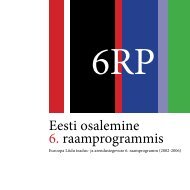Reactive Systems: Modelling, Specification and Verification - Cs.ioc.ee
Reactive Systems: Modelling, Specification and Verification - Cs.ioc.ee
Reactive Systems: Modelling, Specification and Verification - Cs.ioc.ee
Create successful ePaper yourself
Turn your PDF publications into a flip-book with our unique Google optimized e-Paper software.
158 CHAPTER 7. MODELLING MUTUAL EXCLUSION ALGORITHMS<br />
initial value of the variable k can be arbitrary. In order to ensure mutual exclusion,<br />
each process Pi (i ∈ {1, 2}) executes the following algorithm, where we use j to<br />
denote the index of the other process.<br />
while true do<br />
begin<br />
‘noncritical section’;<br />
bi := true;<br />
k := j;<br />
while (bj <strong>and</strong> k = j) do skip;<br />
‘critical section’;<br />
bi := false;<br />
end<br />
As many concurrent algorithms in the literature, Peterson’s mutual exclusion algorithm<br />
is presented in pseudocode. Therefore one of our tasks, when modelling the<br />
above algorithm, is to translate the pseudocode description of the behaviour of the<br />
processes P1 <strong>and</strong> P2 into the model of labelled transition systems or into Milner’s<br />
CCS. Moreover, the algorithm uses variables that are manipulated by the processes<br />
P1 <strong>and</strong> P2. Variables are not part of CCS because, as discussed in Section 1.2,<br />
process calculi like CCS are based on the message passing paradigm, <strong>and</strong> not on<br />
shared variables. However, this is not a major problem. In fact, following the<br />
message passing paradigm, we can view variables as processes that are willing to<br />
communicate with other computing agents in their environment that n<strong>ee</strong>d to read<br />
<strong>and</strong>/or write them.<br />
By way of example, let us consider how to represent the boolean variable b1 as<br />
a process. This variable will be encoded as a process with two states, namely B1t<br />
an B1f. The former state will describe the ‘behaviour’ of the variable b1 holding<br />
the value true, <strong>and</strong> the latter the ‘behaviour’ of the variable b1 holding the value<br />
false. No matter what its value is, the variable b1 can be read (yielding information<br />
on its value to the reading process) or written (possibly changing the value held<br />
by the variable). We n<strong>ee</strong>d to describe these possibilities in CCS. To this end, we<br />
shall assume that processes read <strong>and</strong> write variables by communicating with them<br />
using suitable communication ports. For instance, a process wishing to read the<br />
value true from variable b1 will try to synchronize with the process representing<br />
that variable on a specific communication channel, say b1rt—the acronym means<br />
‘read the value true from b1’. Similarly, a process wishing to write the value false<br />
into variable b1 will try to synchronize with the process representing that variable<br />
on the communication channel b1wf—‘write false into b1’.<br />
Using these ideas, the behaviour of the process describing the variable b1 can<br />
be represented by the following CCS expressions:
















